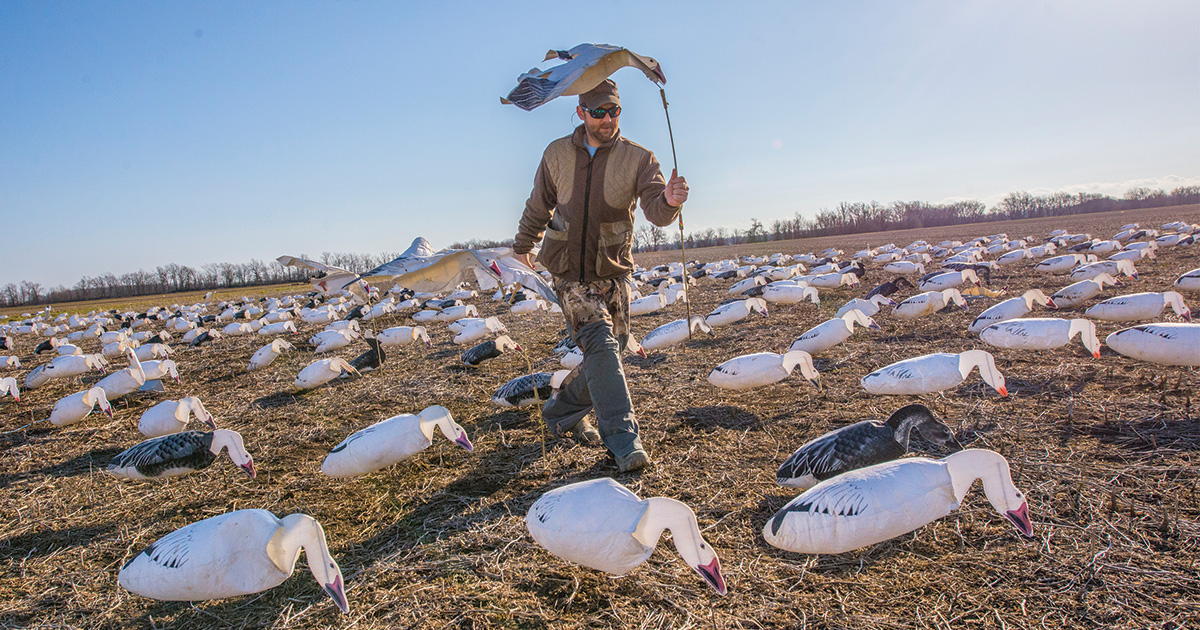Strategies for Spring Snows
Helpful tips for hunting light geese on their northward migration
Helpful tips for hunting light geese on their northward migration

From the Ducks Unlimited magazine Archives | Updated: February 2024

It's no secret that spring snow goose hunting often involves a major commitment of time, money, and effort, but for those who pursue these prolific birds, the rewards can be huge. Following is sage advice from four snow goose gurus on how you can maximize your success during this year's conservation order.
Light geese tend to follow specific migration corridors, and while there are year-to-year variations in bird numbers and the timing of the migration, hunters can usually find large concentrations of snows on traditional staging areas. "These hot spots are a good place to start scouting and determine how the migration is progressing," says Avery pro-staffer Ben Fujan, who hunts light geese every spring from Missouri to Canada. "Once you find some birds and establish their flight patterns, you can start knocking on doors and securing permission to hunt particular fields."
In areas where large numbers of snow geese are staging, Fujan prefers to hunt fields that are several miles to the south of the biggest concentrations of birds. "You simply cannot compete with that many live birds," he says. "But if you set up in the flight path, you can intercept flocks that are just arriving in the area. Another advantage is that you can hunt high-traffic fields for a few days without moving your spread, which saves you a lot of time and effort."
After more than a decade of guiding spring snow goose hunters in South Dakota, Alex Russo has learned to be picky about the types of fields he hunts. "You may find a field that is holding a ton of snow geese, but if you don't have enough standing stubble to hide your layout blinds, you are often better off hunting someplace else. When we scout, we look not only for birds but also stubble or other crop residue that we can use for concealment. That can make all the difference in the quality of your hunt."
In some cases, Russo has no choice other than to hunt a "naked" fieldone with little cover in which to conceal his layout blinds. In this situation, Russo says snow goose hunters have a couple of options.
"One technique is to really load the decoys around your blinds, which will help you to some extent. But we usually place our blinds in grassy field edges and along fence lines—anywhere we can find some vertical cover. It isn't ideal, but it gets the job done."
When the going gets really tough, professional photographer and Avery pro-staffer Doug Steinke likes to mix things up, and his favorite way to throw snow geese a curve is to set up on the edge of a flooded field or open pond. "My hunting buddies and I discovered early on that we could have tremendous success hunting these birds over water," Steinke says. "We typically deploy only five to six dozen floaters and two to three dozen full-body decoys on the bank. There are days when numbers really count and you'll want to use more decoys, but overall we can get by with less when we hunt over water."
Pursuing snow geese in the spring is almost always a challenge, so another key to success is being ready to tackle adversity head-on. "On any given day, you're going to run into a host of problems: melting snow, deep mud, high winds, broken equipment—the list goes on," says South Dakota waterfowl guide Charles Hamre. "That's why I always pack extra batteries and chargers and various spare parts for my e-callers and motion decoys. I also make sure that I have enough cooler space to keep birds on ice if the weather is warm. Snow geese are tough enough to hunt as it is, so being prepared will save you a lot of trouble."
Ducks Unlimited uses cookies to enhance your browsing experience, optimize site functionality, analyze traffic, and deliver personalized advertising through third parties. By continuing to use this site, you agree to our use of cookies. View Privacy Policy